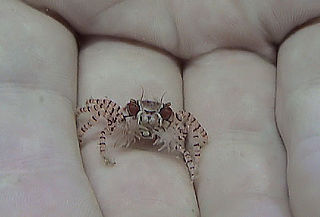Related Research Articles

Xanthidae is a family of crabs known as gorilla crabs, mud crabs, pebble crabs or rubble crabs. Xanthid crabs are often brightly coloured and are highly poisonous, containing toxins which are not destroyed by cooking and for which no antidote is known. The toxins are similar to the tetrodotoxin and saxitoxin produced by puffer fish, and may be produced by bacteria in the genus Vibrio living in symbiosis with the crabs, mostly V. alginolyticus and V. parahaemolyticus.

Xanthoidea is a superfamily of crabs, comprising the three families Xanthidae, Panopeidae and Pseudorhombilidae. Formerly, a number of other families were included in Xanthoidea, but many of these have since been removed to other superfamilies. These include Carpilioidea, Eriphioidea, Hexapodoidea, Pilumnoidea and Trapezioidea. Even in this reduced state, Xanthoidea remains one of the most species-rich superfamilies of crabs.

Lybia is a genus of small crabs in the family Xanthidae. Their common names include boxer crabs, boxing crabs and pom-pom crabs. They are notable for their mutualism with sea anemones, which they hold in their claws for defense. In return, the anemones get carried around which may enable them to capture more food particles with their tentacles. Boxer crabs use at least three species of anemones, including Bundeopsis spp. and Triactis producta. The bonding with the anemone is not needed for survival, however, and boxer crabs have frequently been known to live without them, sometimes substituting other organisms such as sponges and corals for the sea anemones.
Tanaocheles is a genus of crabs, the only genus in the family Tanaocheleidae. It contains two species, T. bidentata and T. stenochilus. The two species were formerly placed in different families, and they were only shown to be related, and placed in a new subfamily, in 2000.

Xantho is a genus of crabs in the family Xanthidae, containing five extant species, all restricted to the north-east Atlantic Ocean and Mediterranean Sea, although Xantho granulicarpis is not universally recognised as a separate species from Xantho hydrophilus:
Cymo is a genus of crabs in the family Xanthidae, containing the following species:
Hepatoporus is a genus of crabs in the family Xanthidae, containing the following species:
Medaeops is a genus of crabs in the family Xanthidae, containing the following species:

Medaeus is a genus of crabs in the family Xanthidae, containing the following species:

Antrocarcinus petrosus is a species of crab in the family Xanthidae, the only species in the genus Antrocarcinus.
Cyrtocarcinus truncatus is a species of crab in the family Xanthidae that lives in the waters around Hawaii. It was described in 1906 by Mary J. Rathbun as Harrovia truncata, based on a single immature male specimen caught near Kauai. Masatsune Takeda transferred the species to his new genus Glyptocarcinus in 1979, and Peter Ng and Diana Chia erected a new genus, Cyrtocarcinus, for this species alone, in 1994.

Glyptoxanthus is a genus of crabs in the family Xanthidae, containing the following species: It was originally erected by Alphonse Milne-Edwards in 1879 for six species previously placed in the genus Actaea and elsewhere. Although previously included in subfamily Euxanthinae, the genus has a quite distinct morphology from other genera in that group, and was placed in 2011 in the new, monotypic subfamily, Glyptoxanthinae by Jose Christopher Mendoza and Danièle Guinot.
Palatigum trichostoma is a species of crabs in the family Xanthidae, the only species in the genus Palatigum.
Polydectus cupulifer is a species of crab in the family Xanthidae, and the only species in the genus Polydectus. Together with the genus Lybia, it forms the subfamily Polydectinae. It is found in the Indo-Pacific, ranging from Madagascar and the Red Sea in the west to Japan, Hawaii and French Polynesia in the east. P. cupulifer is densely covered with setae (bristles), and frequently carries a sea anemone in each chela (claw).

Demania is a genus of crabs in the family Xanthidae, containing the following species:
Euryxanthops is a genus of crabs in the family Xanthidae. It was originally established in 1983 by Garth & Kim to contain three species of deep-water crabs from Japan and the Philippines - Euryxanthops dorsiconvexus, Euryxanthops flexidentatus and Euryxanthops orientalis. Since then, several more species of this genus have been identified and described, and Euryxanthops currently contains:
Marratha angusta is a species of crabs in the family Xanthidae, the only species in the genus Marratha. It was originally described as Cycloxanthops angustus by Mary J. Rathbun in 1906, but was moved to a new genus in 2003; the name of the genus, Marratha, is an "arbitrary abbreviation" of Rathbun's name. It has been recorded from the Amirante Islands (Seychelles), Hawaii and the South China Sea.

Paraxanthus barbiger is a species of crabs in the family Xanthidae, the only species in the genus Paraxanthus.
Pulcratis reticulatus is a species of crabs in the family Xanthidae, the only species in the genus Pulcratis.
Rizalthus anconis is a species of crabs in the family Xanthidae, the only species in the genus Rizalthus.
References
- ↑ Jose Christopher E. Mendoza & Peter K.L. Ng (2008). "New genera and species of euxanthine crabs (Crustacea: decapoda: Brachyura: Xanthidae) from the Bohol Sea, The Philippines" (PDF). Raffles Bulletin of Zoology . 56: 385–404.
| | This crab article is a stub. You can help Wikipedia by expanding it. |